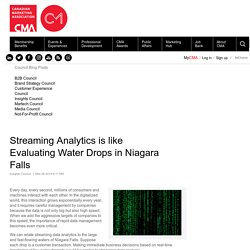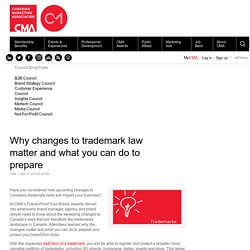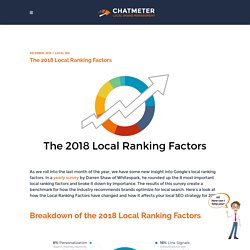

Reputation should be managed as a financial asset. Globally, we have trust issues.

All you need to do is watch the news or scroll through Twitter for five minutes to witness examples of mistrust, mistruths and misinformation. And, Canada is not immune; we struggle with trust in our government, news media, social media and businesses. As Canadians, we should all be concerned, but why is reputation and trust management so important for marketing and communications professionals in particular? Reputation has historically been difficult to measure, as it presumes some correlation between a good or bad reputation and sales or stock value. However, our industry is getting better at quantifying this intangible asset so we can better understand the implications when a business takes a hit.
A study by the World Economic Forum reports that more than 25 per cent of a company’s market value is directly attributable to its reputation. You should care, trust me. Streaming Analytics is like Evaluating Water Drops in Niagara Falls. Every day, every second, millions of consumers and machines interact with each other.

In the digitalized world, this interaction grows exponentially every year, and it requires careful management by companies because the data is not only big but also high speed. When we add the aggressive targets of companies to this speed, the importance of rapid data management becomes even more critical. We can relate streaming data analytics to the large and fast-flowing waters of Niagara Falls. Why changes to trademark law matter and what you can do to prepare. Have you considered how upcoming changes to Canadian trademark rules will impact your business?

At CMA’s Future-Proof Your Brand, experts delved into what every brand manager, agency and brand lawyer need to know about the sweeping changes to Canada’s laws that will transform the trademarks landscape in Canada. Attendees learned why the changes matter and what you can do to prepare and protect your brand from trolls.
With the expanded definition of a trademark, you will be able to register and protect a broader, more valuable portfolio of trademarks, including 3D objects, holograms, tastes, scents and more. This larger portfolio of trademarks rights is valuable to a brand and is a shield to protect your business and will enable you to more fully articulate the elements of your brand. Further changes include the shortening of the renewal period for new registrations from 15 to 10 years and increased filing fees. Cefrio portrait logistique commerce electronique au quebec.
Netendances2018 services bancaires en ligne. Netendances2018 portraitnumeriquefoyersquebecois. Netendances 2018 medias sociaux. Netendances 2018 maison inteligente. News, Tips, and Advice for Technology Professionals. Most spam filters use a scoring system.

Each offense has a value. The higher the sum of a message's offenses, the more likely a spam filter will reroute the message (or not delivered at all). A lone offense usually isn't enough to flag a message as spam; it takes a combination of violations to score high enough to meet the level of true spam. But the system isn't perfect, and sometimes overzealous filters flag legitimate messages as spam.
Applying the following do's and don'ts will help you ensure that your legitimate messages pass the spam filter test and reach their intended Inboxes. Note: This article is also available as a PDF download. 1: Do curtail your excitement Specific words and phrases are the number one hook for spammers, and that makes them the best tool for catching spam. Avoid using words and phrases that trigger spam filters. 2: Do use plain text An email that consists of all HTML or all images and links will trip a spam alarm. 3: Don't include attachments.
News, Tips, and Advice for Technology Professionals. What’s the Best Time to Send Email? Here’s What the Data Says (2019) 2018 Google Ranking Factors Results. The 2018 Local Ranking Factors As we roll into the last month of the year, we have some new insight into Google’s local ranking factors.

In a yearly survey by Darren Shaw of Whitespark, he rounded up the 8 most important local ranking factors and broke it down by importance. The results of this survey create a benchmark for how the industry recommends brands optimize for local search. Here’s a look at how the Local Ranking Factors have changed and how it affects your local SEO strategy for 2019. Breakdown of the 2018 Local Ranking Factors How the Local Ranking Factors Have Changed There have been many changes in the local ranking factors in just the past year. 2017 Local Ranking Factors Change From 2017 to 2018 Google My Business (GMB) Signals The biggest change in local ranking factors is the emphasis on GMB signals.
Recent updates to the GMB knowledge panel: Google Posts and Video postsGoogle Q&AServicesMessaging Review Signals Citation Signals What The Local Ranking Factors Mean For 2019 1. 2. Berners-Lee's Case #ForTheWeb. On Monday, November 5, Tim Berners-Lee unveiled a document called “The Case for the Web” which outlines principles to protect and enhance the web’s future, as well as craft a collective contract for May 2019.

He revealed these plans for a contract at the Web Summit in Lisbon, together with his organization, the Web Foundation. Signers to join the contract thus far include Facebook, Google, the French Government, Sir Richard Branson, the Georgia Institute of Technology, and more than fifty other organizations and key individuals.
Amazon has reportedly not yet joined. The contract is expected to be finalized in May 2019, the year when the web celebrates its 30th birthday, and when half of the world’s population is expected to be online. Les 50 chiffres à connaître sur les médias sociaux en 2018. Chaque année, nous publions un récapitulatif des statistiques des réseaux sociaux.

Facebook, Instagram, Snapchat, Twitter, LinkedIn… cet article permet de visualiser les forces en présence et les dynamiques des réseaux sociaux. Au cours de l’année, pour accéder aux chiffres régulièrement mis à jour, rendez-vous sur cette page : Chiffres réseaux sociaux – 2019. Les chiffres clés des réseaux sociaux en 2018 Selon les derniers chiffres compilés par l’agence We Are Social Singapour et Hootsuite, nous sommes 7,5 milliards d’habitants sur Terre. On dénombre : Les grandes banques canadiennes haussent leur taux préférentiel à 3,45%